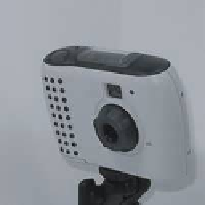Graphics Reference
In-Depth Information
• cannot be parallel to the viewing direction;
• does not need to be normalized;
• does not need to be perpendicular to the view vector.
Recall that the image plane is perpendicular to the view vector. The above last
point says that although the up direction of the image plane is derived based on
the up vector, the two directions do not need to be parallel. For example, in
Figure 14.2, we know that the view vector is looking downward from
y
V
n
V
a
δ
10
=
toward
y
0. This means that none of
V
a
,
V
b
,or
V
c
is perpendicular to the view
vector. Figure 14.4 illustrates the details for the case of the
V
a
up vector. In this
case,
V
n
is perpendicular to the view vector and points in the up direction of the
image plane. Here we see that although the direction of
V
n
is derived from that of
=
View
Vector
V
a
, these two vectors are not parallel. We will explore the relationship between
these two vectors in much more detail in Section 14.3.
In general, it is nontrivial to derive the actual up direction of the image plane.
As a result, the up vector we specify is almost never parallel to the actual up
direction of the image plane. An alternative approach to specify the up direction
is by describing a rotation. A
twist angle
describes a rotation of the
y
-axis with
respect to the view vector. Typically a 0
◦
twist angle refers to the
y
-axis, the
default convention for up. For example, Figure 14.2 shows that in this case, the
three camera orientations can also be described as angular offsets from the scene's
y
-axis, with 0
◦
corresponding to
V
a
,
Figure 14.4.
The up vec-
tor.
θ
=
45
◦
corresponding to
V
b
,and
β
=
90
◦
corresponding to
V
c
.
One last note on Figure 14.2: besides changing the camera twist, for the clar-
ity of illustration, the three camera positions are also rotated with respect to the
tripod support. In practice, the twist angle is measured with respect to the viewing
direction, so changing the twist angle should not alter the camera position.
At the functional level, both the eye and the camera are image-capturing de-
vices. We could have replaced all occurrences of “camera” with “eye” in the
above presentation, and all of the discussions would still be valid. For example,
“we can define an eye position, a look-at position, and orient our eye based on the
up vector to capture an image.” In fact, the camera position is often referred to as
the eye position. In interactive computer graphics, “eye” and “camera” are often
used interchangeably.
Tutorial 14.1.
Project Name:
AdjustCamera
Library Support:
UWB_MFC_Lib1
Tutorial 14.1. The Viewing Parameters
•
Goal.
Understand the camera parameters and verify the effect of changing
these parameters.




















Search WWH ::

Custom Search